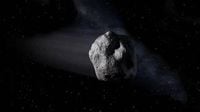In a startling development, scientists are closely monitoring an asteroid named 2024 YR4, which is currently hurtling toward Earth at an alarming speed of 62,000 kilometers per hour. This celestial body, measuring between 53 and 67 meters in diameter, could potentially collide with our planet in just seven years, creating a massive crater estimated to be 34 kilometers wide. Such a collision would release energy equivalent to 500 atomic bombs like those dropped on Hiroshima.
While the thought of an asteroid hitting Earth may evoke images of catastrophic destruction, it’s important to note that the likelihood of this particular event is quite low. Current calculations suggest that the probability of 2024 YR4 impacting Earth in 2032 stands at less than 1%. This is a significant drop from the initial estimate of 3.1% when the asteroid was first detected at the end of last year.
Asteroids striking Earth are not as rare as one might think. In fact, objects around 25 meters in diameter collide with our planet approximately every ten years, often causing explosions comparable to thousands of tons of TNT. However, most of these impacts do not lead to global consequences. The real concern arises with larger asteroids, particularly those measuring hundreds of meters across, which are estimated to strike Earth every 500,000 to one million years.
The potential impact of 2024 YR4 has reignited discussions about the importance of monitoring near-Earth objects. The asteroid is now classified as an object requiring close observation due to its dangerous approach trajectory. If it were to collide with Earth, the aftermath could include large-scale fires, devastating tsunamis, and a significant release of particles into the atmosphere, leading to a temporary drop in global temperatures and altered climate patterns—a phenomenon known as an "impact winter."
Despite the current low probability of impact, the scientific community is taking no chances. Organizations like NASA and the European Space Agency (ESA) have dedicated programs to monitor potentially hazardous objects. These agencies utilize advanced computational models to predict the orbits of such bodies and assess their likelihood of colliding with Earth.
One of the key initiatives in asteroid deflection research is NASA's Double Asteroid Redirection Test (DART). This mission aims to demonstrate the feasibility of altering an asteroid's trajectory through a controlled impact. The success of such missions could pave the way for future strategies to protect Earth from potential asteroid threats.
Interestingly, the trajectory of 2024 YR4 has shifted, and it is now more likely to collide with the Moon, with a probability of 3.8% in 2032. This development raises questions about the implications of a lunar impact, as the Moon, lacking a protective atmosphere, is frequently subject to meteoroid strikes. An impact on the Moon would create a visible crater, providing valuable data about the geological processes at play on our natural satellite.
As humanity prepares for new manned missions to the Moon, understanding the risks posed by asteroids is crucial. The data gathered from potential lunar impacts will help protect astronauts and equipment during future explorations. Moreover, studying these impacts can aid in developing technologies to safeguard lunar bases from similar threats.
In light of these developments, experts emphasize the need for continuous funding and research into asteroid monitoring and deflection technologies. Although the majority of space objects do not pose an immediate threat, having a robust defense strategy is essential for long-term planetary protection.
The detection of 2024 YR4 has underscored the importance of early warning systems and international cooperation in planetary defense initiatives. While current predictions indicate a minimal risk of impact, scientists remain vigilant, ready to adapt to any changes in the asteroid's trajectory.
For now, the scientific community is committed to closely monitoring 2024 YR4, as well as other near-Earth objects. The potential approach of this asteroid in 2032 offers researchers a critical window to study mitigation strategies and, if necessary, implement diversion actions to protect our planet.
As we advance in our understanding of these celestial threats, the collaboration between space agencies and scientists worldwide will be vital in ensuring the safety of both Earth and future space missions. By staying informed and prepared, humanity can better face the challenges posed by the cosmos.


